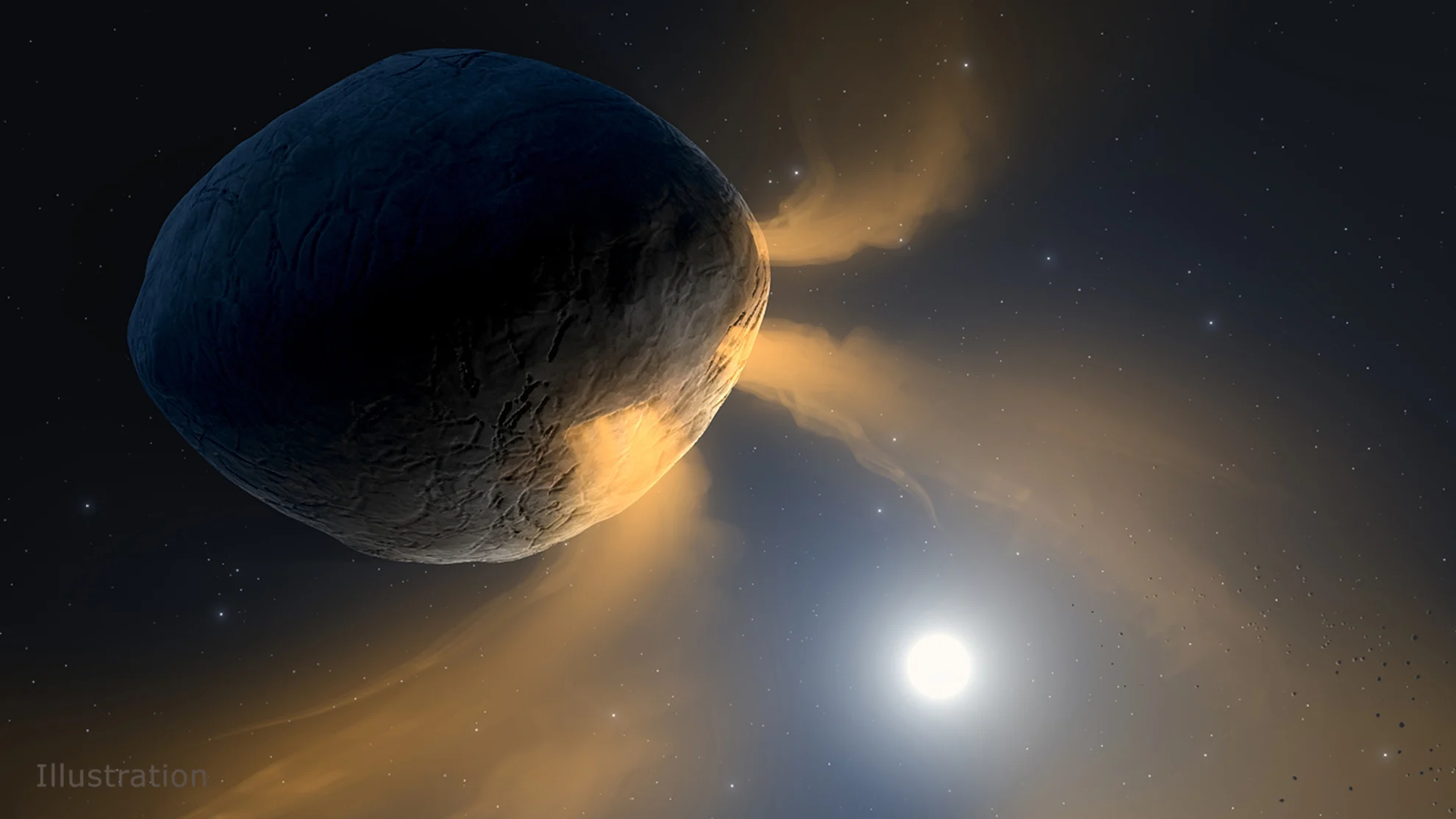
Wow. Weird 'rock comet' 3200 Phaethon is way stranger than we thought!
Just when we thought we had this bizarre asteroid mostly figured out, it still had some surprises for us!
New observations of asteroid 3200 Phaethon have upended years of assumptions about this already bizarre object while adding another layer of mystery to the Geminids, one of the year's best meteor showers.
3200 Phaethon is one of the strangest objects in our solar system. First discovered in 1983, this 6-kilometre-wide space rock looks like it originated in the asteroid belt between Mars and Jupiter. However, it behaves more like a comet than an asteroid, tracing out a highly elliptical and highly inclined path around the Sun that takes it from the middle of the asteroid belt to well within the orbit of Mercury and back out again roughly every 19 months.
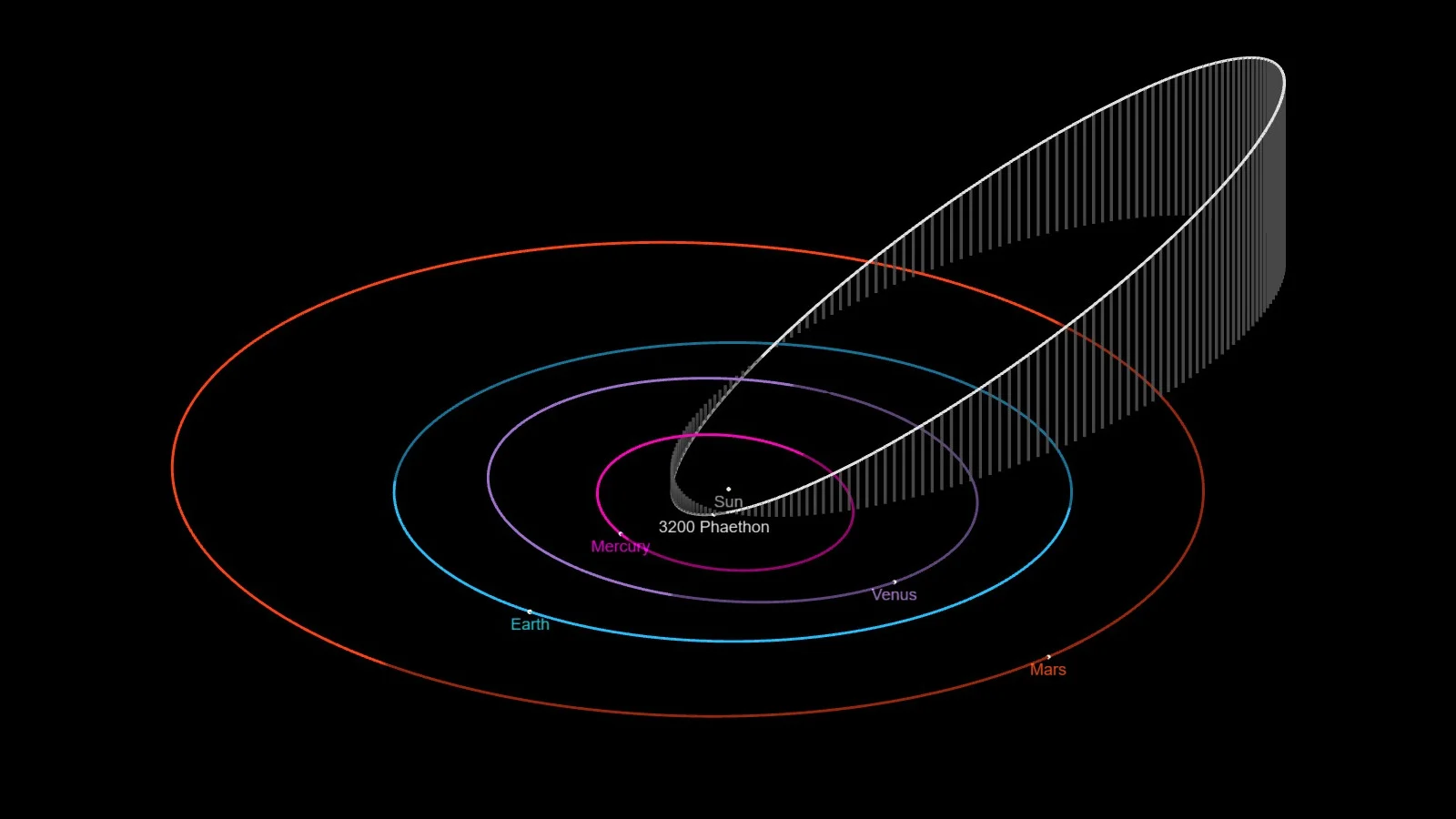
This diagram shows the highly elliptical and highly inclined orbit of 3200 Phaethon compared to the orbits of the inner planets. The positions of the asteroid and the planets are depicted as they were during Phaethon's last perihelion on May 15, 2022. Credit: NASA/JPL-Caltech/Scott Sutherland
Also, each time it makes its closest approach to the Sun, it produces a short but noticeable tail, just as a comet would do.
For this reason, researchers nicknamed Phaethon a 'rock comet.'
From years of studying Phaethon, it appeared as though its tail was made of rock dust, which was expelled from the surface of the asteroid as it baked under the Sun's intense heat during each close pass. Also, the asteroid's debris stream — the material that ultimately produces colourful Geminid meteors in our sky each December — was thought to be fed by this tail each time the asteroid swung around the Sun.
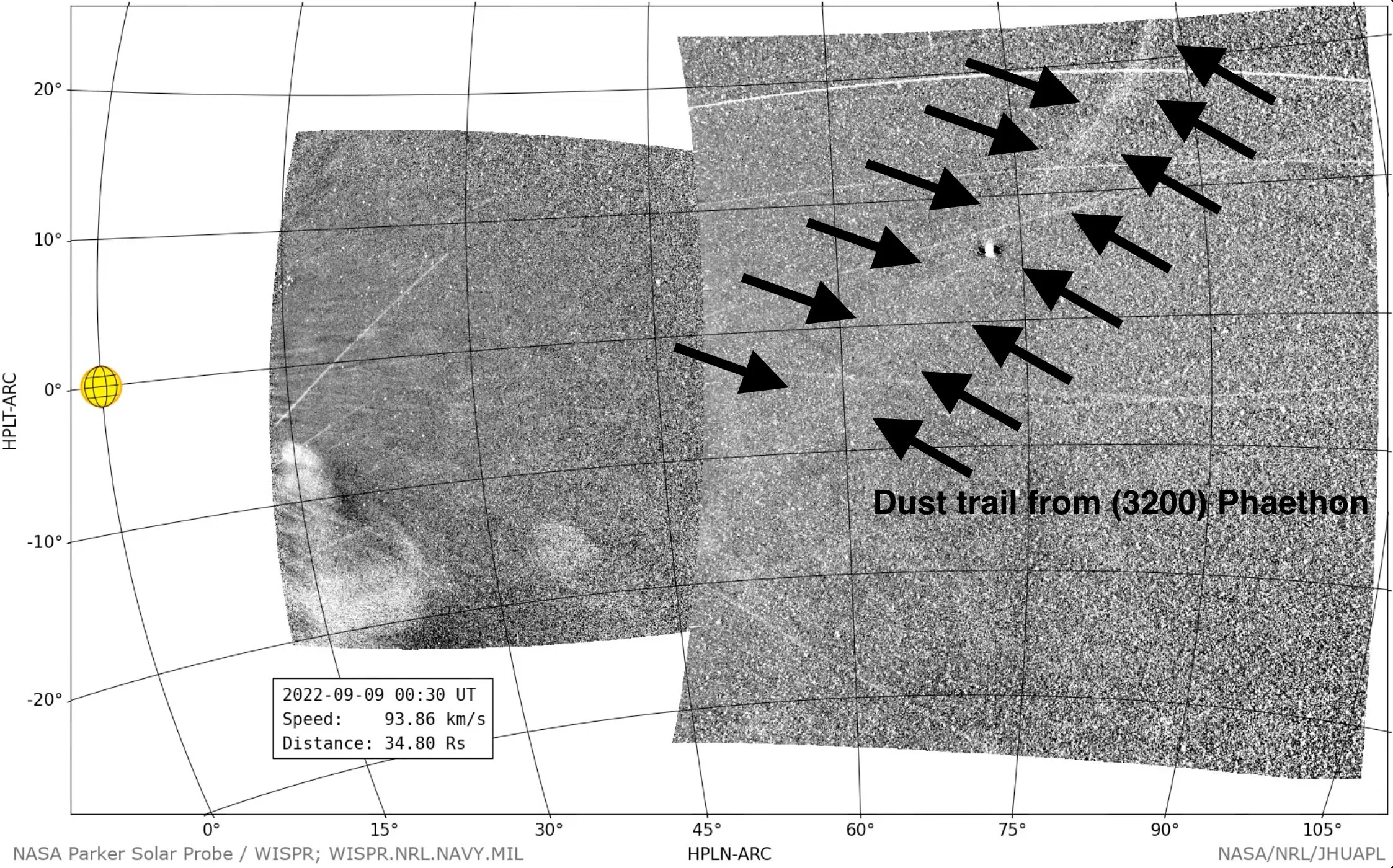
The dust trail shed by 3200 Phaethon (between the black arrows), as seen by the Parker Solar Probe on September 9, 2022. The position and size of the Sun are shown to the left, and the fuzz in the middle is the Milky Way. Streaks are from cosmic rays, and a streamer from the Sun can be seen to the left. Credit: Karl Battams/NASA/NRL/JHUAPL
However, recent observations of Phaethon revealed some unexpected results that challenge those long-held beliefs.
First, a few years ago, NASA's Parker Solar Probe captured the first image of Phaethon's debris stream. Then it snapped a second, closer view in September 2022, as seen above. Analysis of these images confirmed what scientists had been speculating about for some time — that there is so much material in the stream, there's no way the rock comet's tiny tail could account for it all.
Now, new images of the asteroid revealed something even more interesting. 3200 Phaethon's tail doesn't actually contain any dust at all. Instead, it's composed of sodium gas.

This extreme closeup of 3200 Phaethon was captured by one of NASA's STEREO spacecraft in 2010. The rock comet's short tail extends toward the bottom left of the image. Credit: Science@NASA
"Our analysis shows that Phaethon's comet-like activity cannot be explained by any kind of dust," Qicheng Zhang, a Ph.D. student at Caltech, told NASA.
Zhang is the lead author of a new study in the Planetary Science Journal that details these findings. He and his colleagues gathered images of 3200 Phaethon taken by the coronagraph instruments on board SOHO and another NASA spacecraft, the Solar Terrestrial Relations Observatory (STEREO), between 1997 and 2022.
Coronagraphs work by blocking direct sunlight from entering the camera using a small disk. As a result, the instrument can image the fainter activity around the Sun, such as coronal streamers and coronal mass ejections. The instruments also pick up any objects in the view, such as stars, planets, and even comets and asteroids. Additionally, the Large Angle and Spectrometric Coronagraph (LASCO) on the SOHO spacecraft uses two filters for its images: an orange one sensitive to sodium and a blue one that can detect dust.
"When a comet or asteroid gets close to the sun, the intense radiation environment can release a lot of sodium from the object's surface," study co-author Karl Battams, who is the LASCO principal investigator at the U.S. Naval Research Laboratory, said in an NRL press release. "We can use LASCOs filters to look for signatures of sodium or the presence of dust, helping us understand the processes occurring on the surface of the comet or asteroid."
When SOHO caught Phaethon in its field of view, the asteroid's tail shone brightly in the orange-filtered LASCO C2 views. If there was any dust in the tail, it would also show up in the blue-filtered LASCO C3 view. However, it didn't. The asteroid wasn't actually producing any dust that the instrument could pick up.
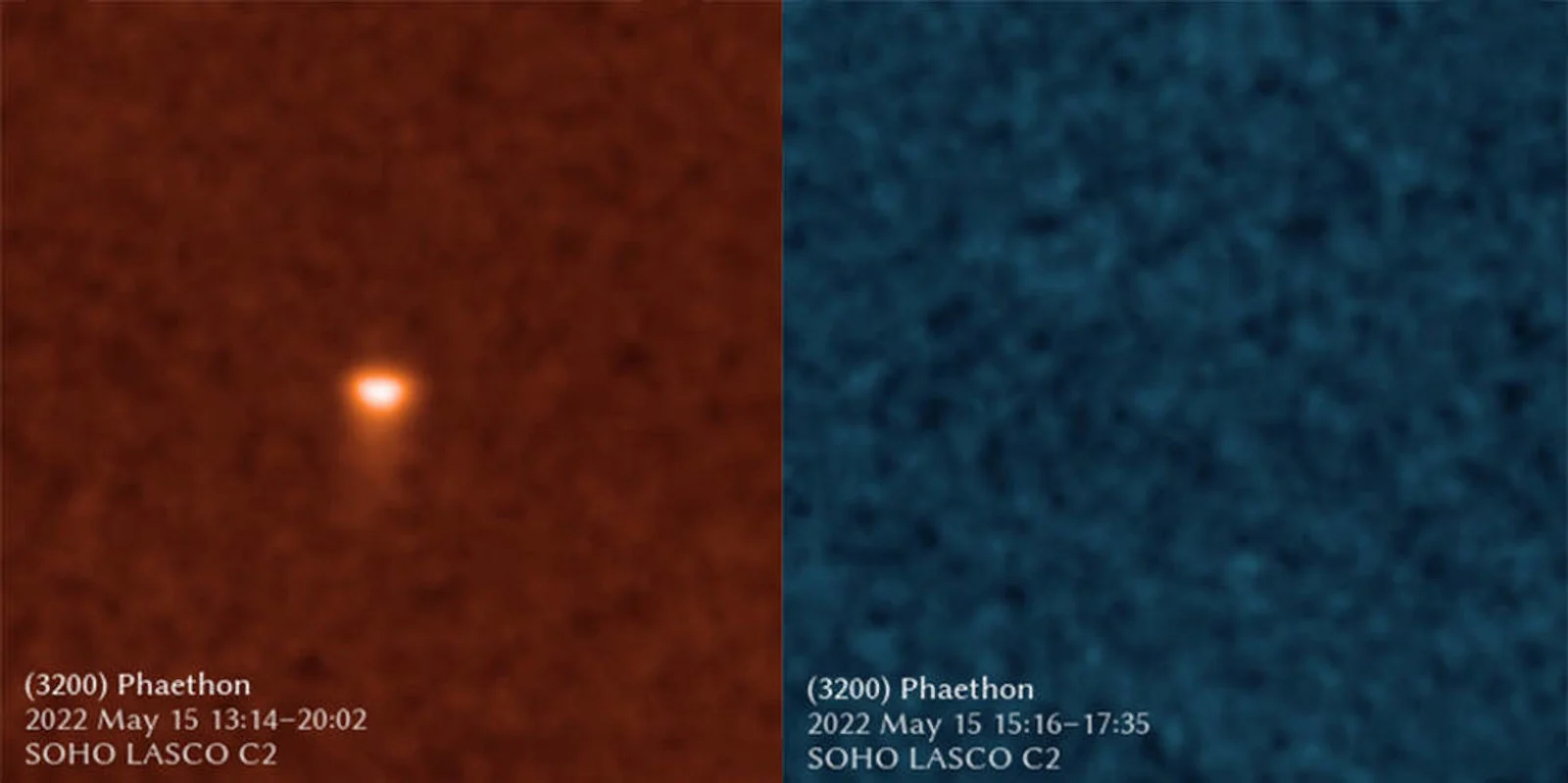
SOHO's orange-filtered LASCO C2 view (left), which can detect sodium, shows asteroid 3200 Phaethon glowing brightly. Meanwhile, the blue-filtered LASCO C3 view of the same region of space (right), which should detect any dust from the asteroid, picks up nothing. Credit: ESA/NASA/Qicheng Zhang
"Even after 27 years, we are still finding novel ways to get unique science out of LASCO," Battams added. "It was never intended to study comets, yet with these recent observations, LASCO has upended years of belief about this asteroid and again demonstrated its unique worth."
With this discovery, there are some lingering questions.
Firstly, are there other objects like Phaethon?
According to Battams' Sungrazer Project page, as of February this year, we have seen over 4,600 sungrazer comets due to SOHO. The Sungrazer Project is a citizen science effort where people scan through SOHO imagery to find comets that make very close approaches to the Sun. Unfortunately, many of these objects are vapourized in the process, but a few have survived.
The study already identifies two possible ones: 322P/SOHO, first spotted in 1999 and expected to make another close pass around the Sun in August of this year, and 323P/SOHO, which was found in 2004 and its last perihelion was in January 2021. So, how many other 'comets' spotted by SOHO might be 'rock comet' asteroids instead?
Secondly, what about the Geminids?
What about the Geminids?
Each year, from early to mid-December, Earth passes through 3200 Phaethon's debris stream, producing the Geminid meteor shower.
The Geminids is one of the best meteor showers of the entire year. It consistently delivers between 100-150 meteors per hour during its peak around December 14. Also, it is well known for its multicoloured meteors, which are caused by the various minerals and metals in the rock dust vapourizing as the micrometeoroids blaze through the atmosphere.
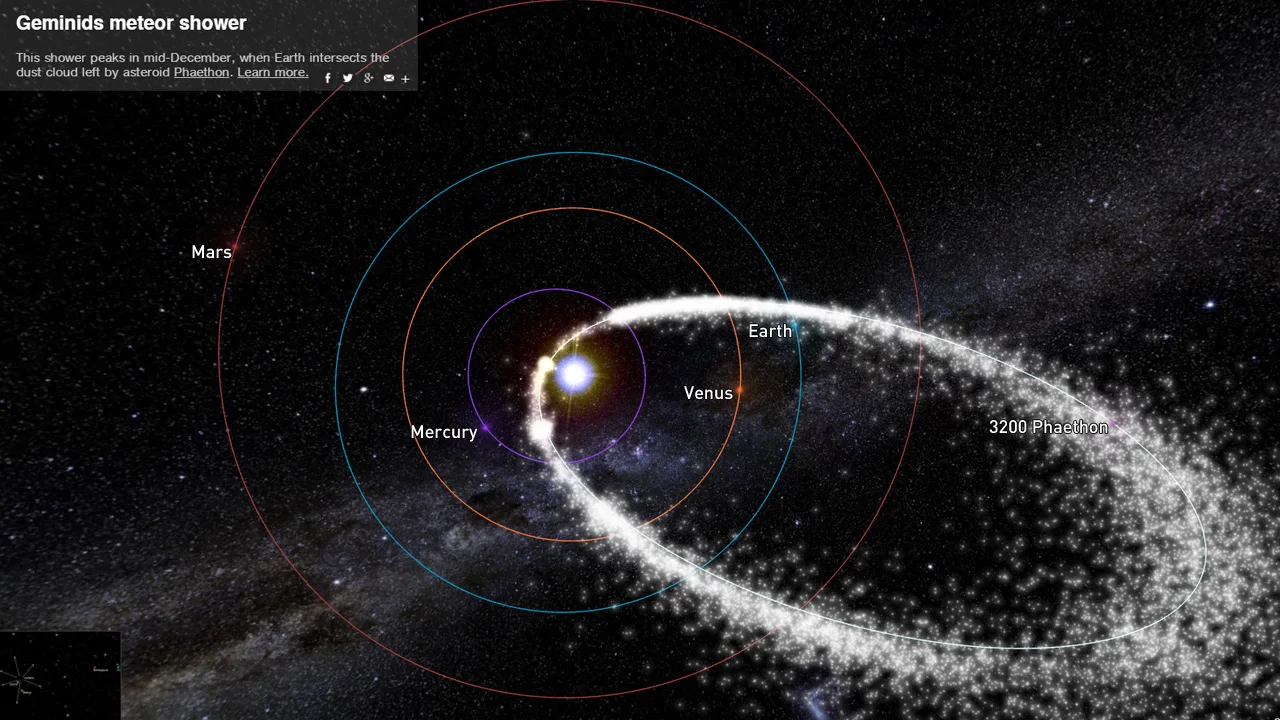
This simulation shows the orbit and debris stream of 'rock comet' 3200 Phaethon. The size of the debris particles is exaggerated here to make it easier for us to see them. Credit: Meteorshowers.org/Scott Sutherland
The shape of Phaethon's orbit and the shape of the Geminid debris stream are too similar to be a coincidence. Thus, the two are most certainly related. However, the debris stream is estimated to contain billions of tonnes of material. So, if Phaethon's tail doesn't contain any dust, where did all that material come from?
According to the study, sodium gas erupting from the surface of Phaethon during its close passage around the Sun could carry material with it, potentially ejecting up to metre-sized boulders into the asteroid's wake. However, some kind of "triggering event" would be needed to kick-start that process. So, either the asteroid was hit by something in the past, or its unusually rapid rotation caused enough stress on it that it fractured.
"More answers may come from an upcoming Japan Aerospace Exploration Agency (JAXA) mission called DESTINY+ (short for Demonstration and Experiment of Space Technology for Interplanetary voyage Phaethon fLyby and dUst Science)," says NASA. "Later this decade, the DESTINY+ spacecraft is expected to fly past Phaethon, imaging its rocky surface and studying any dust that might exist around this enigmatic asteroid."
(Thumbnail image courtesy NASA/JPL-Caltech/IPAC)











